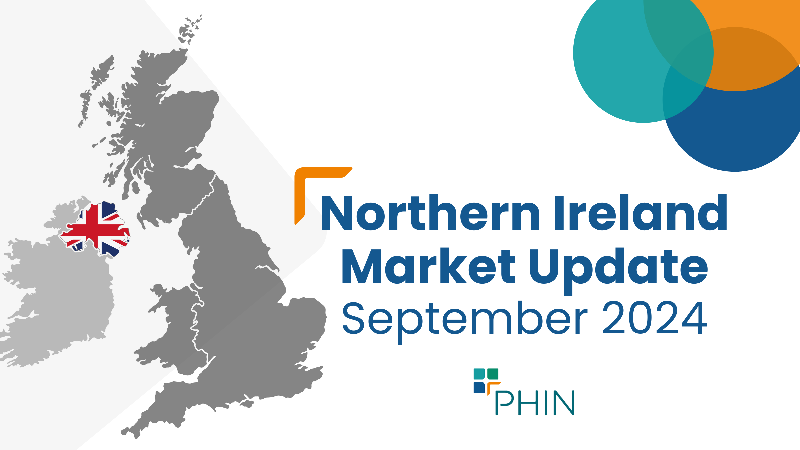In the latest of our quarterly updates, we use our unique, national dataset to look at the key trends in the independent healthcare sector up to, and including, Q1 2024. The data covers private healthcare in-patient/day-case market activity, insured cases, ‘self-pay’, along with national/regional and procedural breakdowns and demographic information. (Q1 = Jan – Mar; Q2 = Apr – Jun; Q3 = Jul – Sep; Q4 Oct – Dec)
Private healthcare sector market activity
In-patient/day-care admissions comparison Q1 2019 – Q1 2024
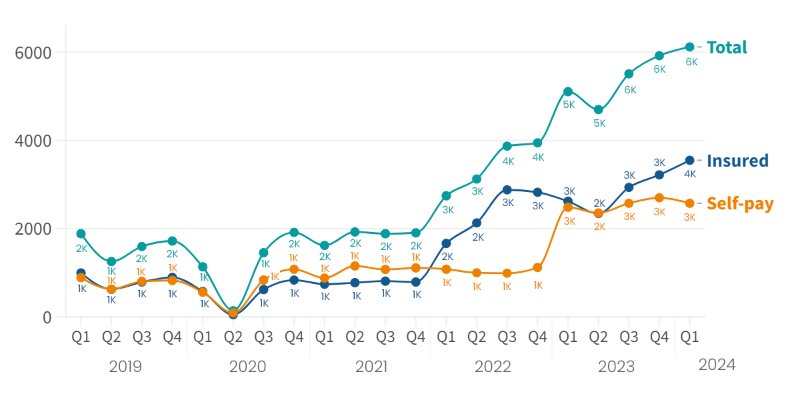
Q1 2024 in Northern Ireland at a glance
- There were over 6,000 reported private in-patient/day-care admissions in a quarter for the first time in Northern Ireland (previously 5,920).
- The use of private medical insurance (PMI) was up 35% from the same quarter in 2023.
- Self-pay – where patients fund their own treatment from their savings, a loan or fundraising – also increased (4%) on same quarter in 2023.
Record independent healthcare in-patient admissions in Northern Ireland in Q1 2024
There were 6,120 reported admissions in Q1 2024, a 20% increase on the equivalent quarter in 2023 (5,105), and a 3% increase from the previous highest quarter (Q4 2023).
Except for Q2 2023, there has been a steady rise in the number of reported admissions in Northern Ireland since Q3 2021.
Some of the increases shown may be due to more complete data submission by the hospital groups in Northern Ireland to PHIN, meaning there is now a more accurate picture of activity.
Admission change by volume in Northern Ireland (Q1 2023 v Q1 2024)
.png)
Private medical insurance admissions continue to grow as self-pay remains steady
Insured admissions
When comparing Q1 2024 to Q1 2023, the number of admissions funded by private medical insurance were up by 35% in Northern Ireland. There was also a 10% increase on the previous quarter (Q4 2023), which had been the previous record high.
Admissions paid for with insurance went down between Q3 2022 to Q2 2023, but have been increasing by quarter ever since.
Self-pay admissions
Self-pay admissions in Northern Ireland were up from the same quarter in 2023 (4%), but down on the previous quarter (Q4 2023) by 5%.
Insured and Self-pay change by % (Q1 2023 v Q1 2024) (based on non-rounded figures)
.png)
Admissions (rounded) in Northern Ireland by payment method (Q1 2023 v Q1 2024)

Top 10 procedures (Q1 2023 v Q1 2024)
.png)
There was an increase in reported admissions in each of the top 10 procedures by volume when comparing Q1 2023 and Q1 2024.
‘Cataract surgery’ had the biggest increase at 331%. Only two of the Top 10 had increases of less that 100%. These large rises are likely to be a combination of an increase in admissions combined with more complete data submission to PHIN.
Active consultants in private healthcare
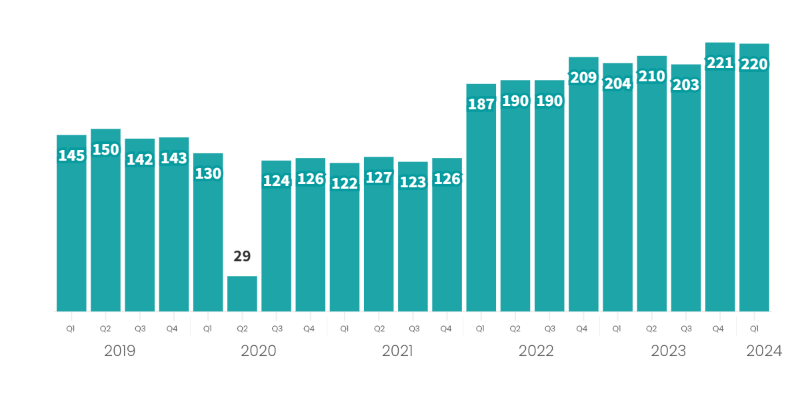
The number of consultants active in private healthcare regularly fluctuates, but remained high in Northern Ireland in Q1 2024, down just 0.5% on Q4 2023, meaning it was the second highest level since PHIN began collecting data. The number of active consultants in Q1 2024 was 8% higher than Q1 2023.
Quarterly comparison of active consultants for the top 10 PHIN specialties (Q1 2023 v Q1 2024)
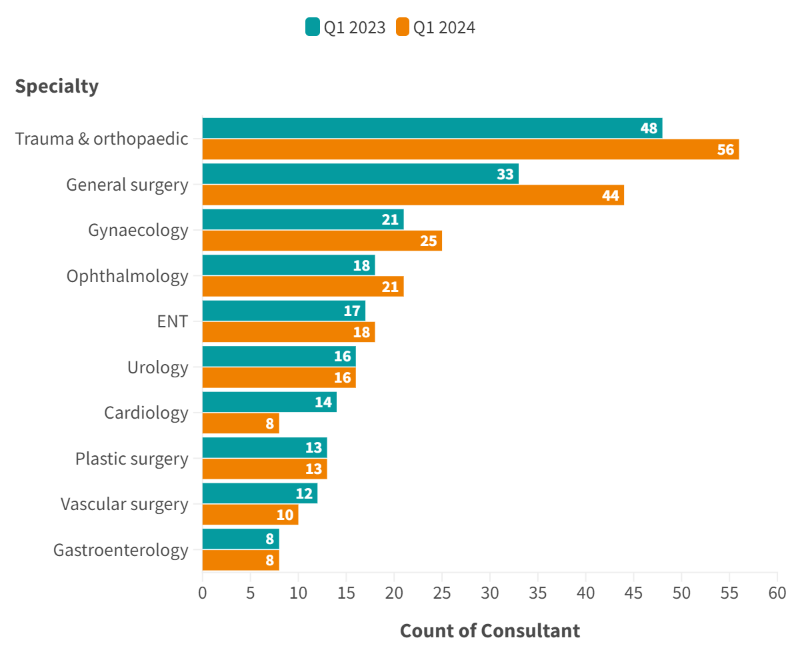
The largest increase in active consultants in the top 10 procedure groups was in ‘General surgery’ with an extra 11 consultants (33%). ‘Trauma & orthopaedics’ had the second largest increase in volume (an extra 8 consultants) and the second largest percentage increase (17%).
Patient demographics
Volume of admissions by sex and payment method (Q1 2023 v Q1 2024)
There was an increased number of insured and self-pay admissions for both sexes compared to the same quarter in 2023.
Insured admissions for males and females both grew by 36%, although the number of females using insurance was higher.
Self-pay admissions also increased at the same rate (2%) for both sexes, although once again there were more female admissions.
The number of admissions was split evenly between the sexes which is quite unusual as there tend to be more female admissions than male ones.
Purchaser type and sex (Q1 2023 v Q1 2024)
.png)
Change in volume of admissions by age
There was an increase in admissions in all age groups from Q1 2023 to Q1 2024 (except for those aged 90 or above for whom there were no admissions).
The largest increase in terms of volume was in the 70-79 age-group (260 extra admissions). The largest increase by volume was in the 20-29 age-group (27%). The 50-59 age-group, which is traditionally the highest user of private healthcare had one of the lowest percentage increases (8%).
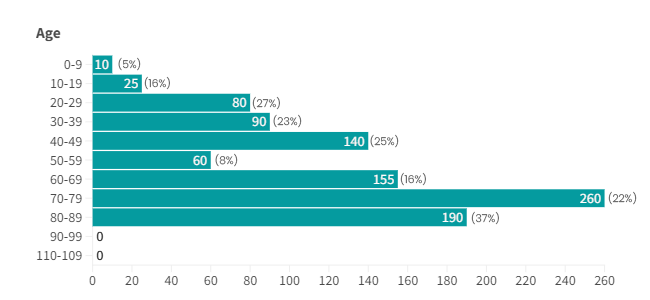
Important notes
All data described above taken from PHIN’s unique, national private dataset describing discharge activity (day case and inpatient). This excludes activity outside of PHIN’s mandate from the Competition and Markets Authority, such as outpatient diagnostics and mental health.
There is a time lag between collecting, validating and processing the data we receive from hospitals before we can publish it. This can be up to 6 months after treatment has been completed, to ensure a fair process and accurate data.
Activity numbers have been rounded to the nearest 5, with percentage based on the unrounded figures.
